Business Project Report: Nestle's Recruitment, Selection, and Training
VerifiedAdded on 2021/02/20
|32
|6903
|40
Report
AI Summary
This report examines a business project focused on Nestle's recruitment, selection, and training practices. It begins by outlining project goals, aims, and objectives, including a case study on Nestle's global operations. The report delves into the project management plan, covering costs, scope, timeframes, and resource allocation. It discusses Gantt charts and work breakdown structures for effective project organization. The research methodology includes both quantitative and qualitative approaches, with a literature review on recruitment, selection, and training. The report further analyzes data using various tools and techniques to formulate recommendations. Finally, it reflects on the value of the research in meeting the stated objectives, concluding with a summary of findings and recommendations for improving Nestle's employee management strategies.
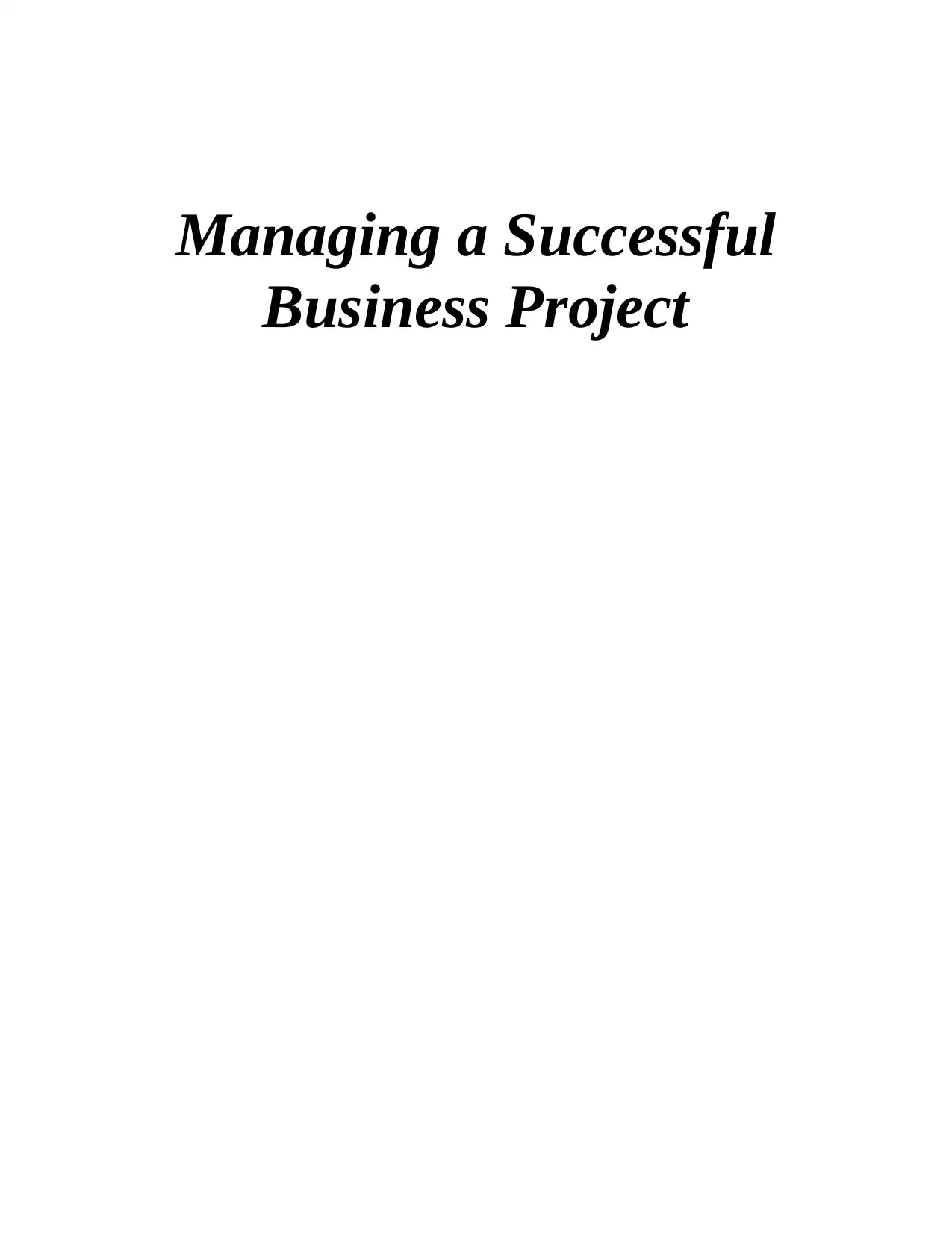
Managing a Successful
Business Project
Business Project
Paraphrase This Document
Need a fresh take? Get an instant paraphrase of this document with our AI Paraphraser
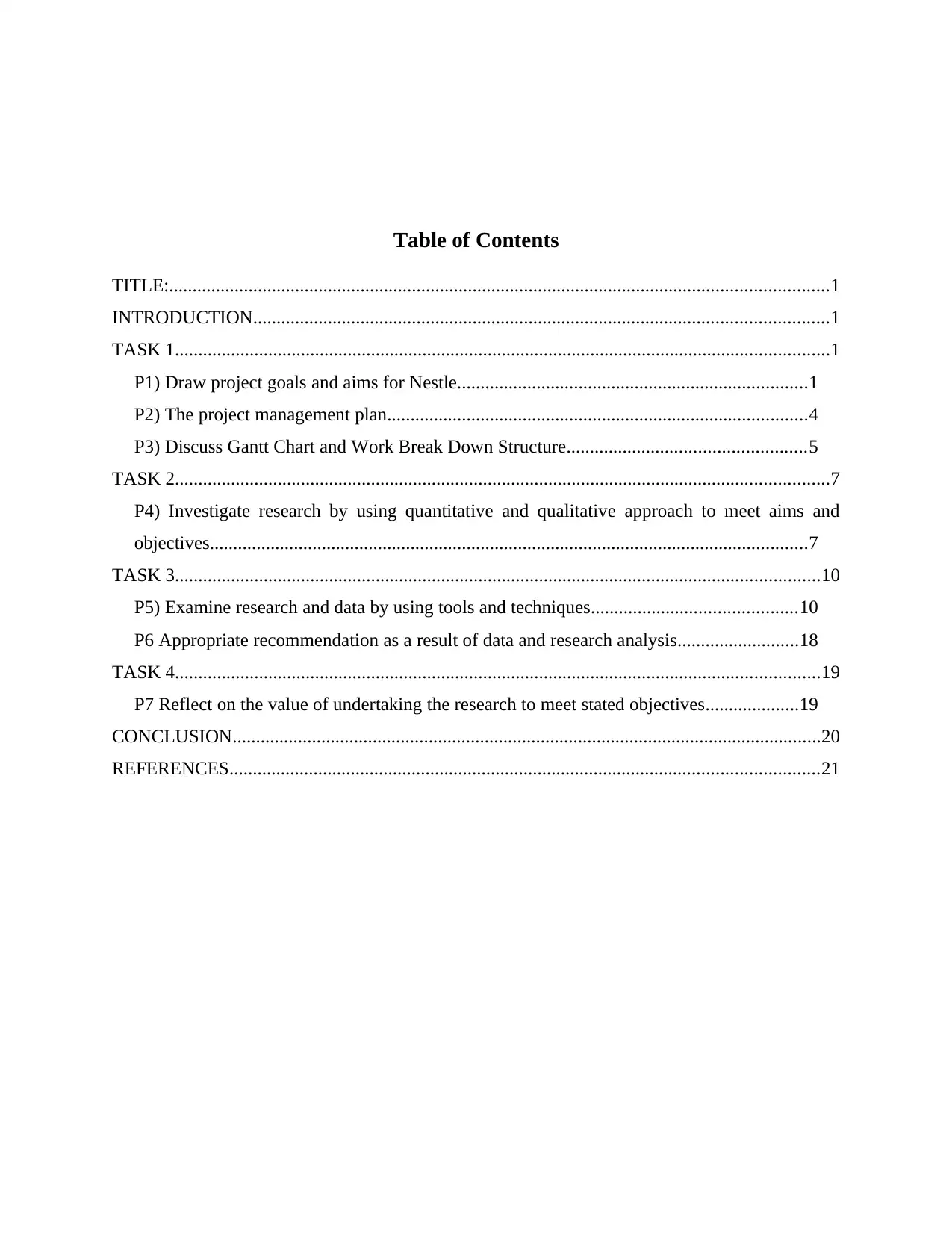
Table of Contents
TITLE:.............................................................................................................................................1
INTRODUCTION...........................................................................................................................1
TASK 1............................................................................................................................................1
P1) Draw project goals and aims for Nestle...........................................................................1
P2) The project management plan..........................................................................................4
P3) Discuss Gantt Chart and Work Break Down Structure...................................................5
TASK 2............................................................................................................................................7
P4) Investigate research by using quantitative and qualitative approach to meet aims and
objectives................................................................................................................................7
TASK 3..........................................................................................................................................10
P5) Examine research and data by using tools and techniques............................................10
P6 Appropriate recommendation as a result of data and research analysis..........................18
TASK 4..........................................................................................................................................19
P7 Reflect on the value of undertaking the research to meet stated objectives....................19
CONCLUSION..............................................................................................................................20
REFERENCES..............................................................................................................................21
TITLE:.............................................................................................................................................1
INTRODUCTION...........................................................................................................................1
TASK 1............................................................................................................................................1
P1) Draw project goals and aims for Nestle...........................................................................1
P2) The project management plan..........................................................................................4
P3) Discuss Gantt Chart and Work Break Down Structure...................................................5
TASK 2............................................................................................................................................7
P4) Investigate research by using quantitative and qualitative approach to meet aims and
objectives................................................................................................................................7
TASK 3..........................................................................................................................................10
P5) Examine research and data by using tools and techniques............................................10
P6 Appropriate recommendation as a result of data and research analysis..........................18
TASK 4..........................................................................................................................................19
P7 Reflect on the value of undertaking the research to meet stated objectives....................19
CONCLUSION..............................................................................................................................20
REFERENCES..............................................................................................................................21
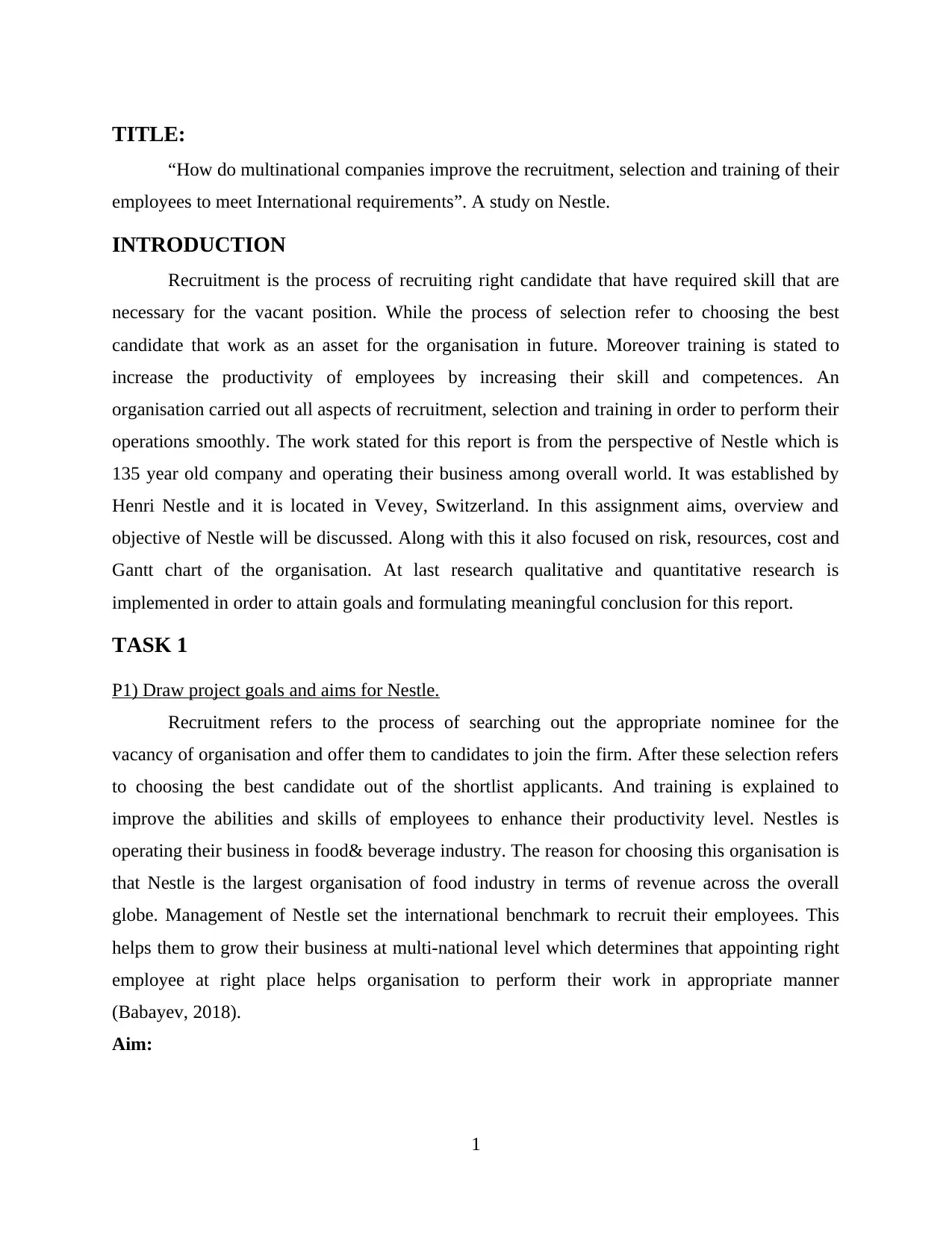
TITLE:
“How do multinational companies improve the recruitment, selection and training of their
employees to meet International requirements”. A study on Nestle.
INTRODUCTION
Recruitment is the process of recruiting right candidate that have required skill that are
necessary for the vacant position. While the process of selection refer to choosing the best
candidate that work as an asset for the organisation in future. Moreover training is stated to
increase the productivity of employees by increasing their skill and competences. An
organisation carried out all aspects of recruitment, selection and training in order to perform their
operations smoothly. The work stated for this report is from the perspective of Nestle which is
135 year old company and operating their business among overall world. It was established by
Henri Nestle and it is located in Vevey, Switzerland. In this assignment aims, overview and
objective of Nestle will be discussed. Along with this it also focused on risk, resources, cost and
Gantt chart of the organisation. At last research qualitative and quantitative research is
implemented in order to attain goals and formulating meaningful conclusion for this report.
TASK 1
P1) Draw project goals and aims for Nestle.
Recruitment refers to the process of searching out the appropriate nominee for the
vacancy of organisation and offer them to candidates to join the firm. After these selection refers
to choosing the best candidate out of the shortlist applicants. And training is explained to
improve the abilities and skills of employees to enhance their productivity level. Nestles is
operating their business in food& beverage industry. The reason for choosing this organisation is
that Nestle is the largest organisation of food industry in terms of revenue across the overall
globe. Management of Nestle set the international benchmark to recruit their employees. This
helps them to grow their business at multi-national level which determines that appointing right
employee at right place helps organisation to perform their work in appropriate manner
(Babayev, 2018).
Aim:
1
“How do multinational companies improve the recruitment, selection and training of their
employees to meet International requirements”. A study on Nestle.
INTRODUCTION
Recruitment is the process of recruiting right candidate that have required skill that are
necessary for the vacant position. While the process of selection refer to choosing the best
candidate that work as an asset for the organisation in future. Moreover training is stated to
increase the productivity of employees by increasing their skill and competences. An
organisation carried out all aspects of recruitment, selection and training in order to perform their
operations smoothly. The work stated for this report is from the perspective of Nestle which is
135 year old company and operating their business among overall world. It was established by
Henri Nestle and it is located in Vevey, Switzerland. In this assignment aims, overview and
objective of Nestle will be discussed. Along with this it also focused on risk, resources, cost and
Gantt chart of the organisation. At last research qualitative and quantitative research is
implemented in order to attain goals and formulating meaningful conclusion for this report.
TASK 1
P1) Draw project goals and aims for Nestle.
Recruitment refers to the process of searching out the appropriate nominee for the
vacancy of organisation and offer them to candidates to join the firm. After these selection refers
to choosing the best candidate out of the shortlist applicants. And training is explained to
improve the abilities and skills of employees to enhance their productivity level. Nestles is
operating their business in food& beverage industry. The reason for choosing this organisation is
that Nestle is the largest organisation of food industry in terms of revenue across the overall
globe. Management of Nestle set the international benchmark to recruit their employees. This
helps them to grow their business at multi-national level which determines that appointing right
employee at right place helps organisation to perform their work in appropriate manner
(Babayev, 2018).
Aim:
1
⊘ This is a preview!⊘
Do you want full access?
Subscribe today to unlock all pages.

Trusted by 1+ million students worldwide
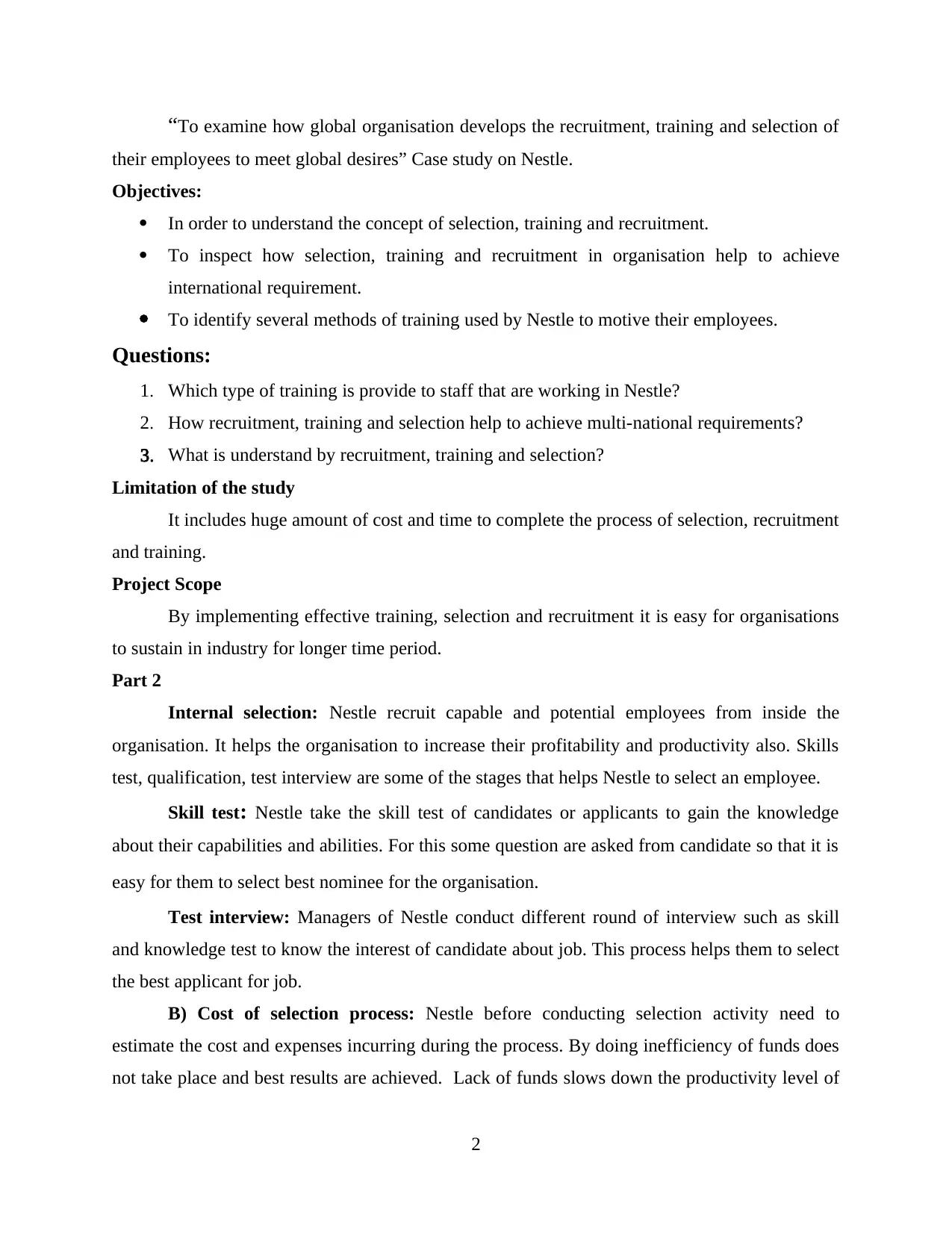
“To examine how global organisation develops the recruitment, training and selection of
their employees to meet global desires” Case study on Nestle.
Objectives:
In order to understand the concept of selection, training and recruitment.
To inspect how selection, training and recruitment in organisation help to achieve
international requirement.
To identify several methods of training used by Nestle to motive their employees.
Questions:
1. Which type of training is provide to staff that are working in Nestle?
2. How recruitment, training and selection help to achieve multi-national requirements?
3. What is understand by recruitment, training and selection?
Limitation of the study
It includes huge amount of cost and time to complete the process of selection, recruitment
and training.
Project Scope
By implementing effective training, selection and recruitment it is easy for organisations
to sustain in industry for longer time period.
Part 2
Internal selection: Nestle recruit capable and potential employees from inside the
organisation. It helps the organisation to increase their profitability and productivity also. Skills
test, qualification, test interview are some of the stages that helps Nestle to select an employee.
Skill test: Nestle take the skill test of candidates or applicants to gain the knowledge
about their capabilities and abilities. For this some question are asked from candidate so that it is
easy for them to select best nominee for the organisation.
Test interview: Managers of Nestle conduct different round of interview such as skill
and knowledge test to know the interest of candidate about job. This process helps them to select
the best applicant for job.
B) Cost of selection process: Nestle before conducting selection activity need to
estimate the cost and expenses incurring during the process. By doing inefficiency of funds does
not take place and best results are achieved. Lack of funds slows down the productivity level of
2
their employees to meet global desires” Case study on Nestle.
Objectives:
In order to understand the concept of selection, training and recruitment.
To inspect how selection, training and recruitment in organisation help to achieve
international requirement.
To identify several methods of training used by Nestle to motive their employees.
Questions:
1. Which type of training is provide to staff that are working in Nestle?
2. How recruitment, training and selection help to achieve multi-national requirements?
3. What is understand by recruitment, training and selection?
Limitation of the study
It includes huge amount of cost and time to complete the process of selection, recruitment
and training.
Project Scope
By implementing effective training, selection and recruitment it is easy for organisations
to sustain in industry for longer time period.
Part 2
Internal selection: Nestle recruit capable and potential employees from inside the
organisation. It helps the organisation to increase their profitability and productivity also. Skills
test, qualification, test interview are some of the stages that helps Nestle to select an employee.
Skill test: Nestle take the skill test of candidates or applicants to gain the knowledge
about their capabilities and abilities. For this some question are asked from candidate so that it is
easy for them to select best nominee for the organisation.
Test interview: Managers of Nestle conduct different round of interview such as skill
and knowledge test to know the interest of candidate about job. This process helps them to select
the best applicant for job.
B) Cost of selection process: Nestle before conducting selection activity need to
estimate the cost and expenses incurring during the process. By doing inefficiency of funds does
not take place and best results are achieved. Lack of funds slows down the productivity level of
2
Paraphrase This Document
Need a fresh take? Get an instant paraphrase of this document with our AI Paraphraser
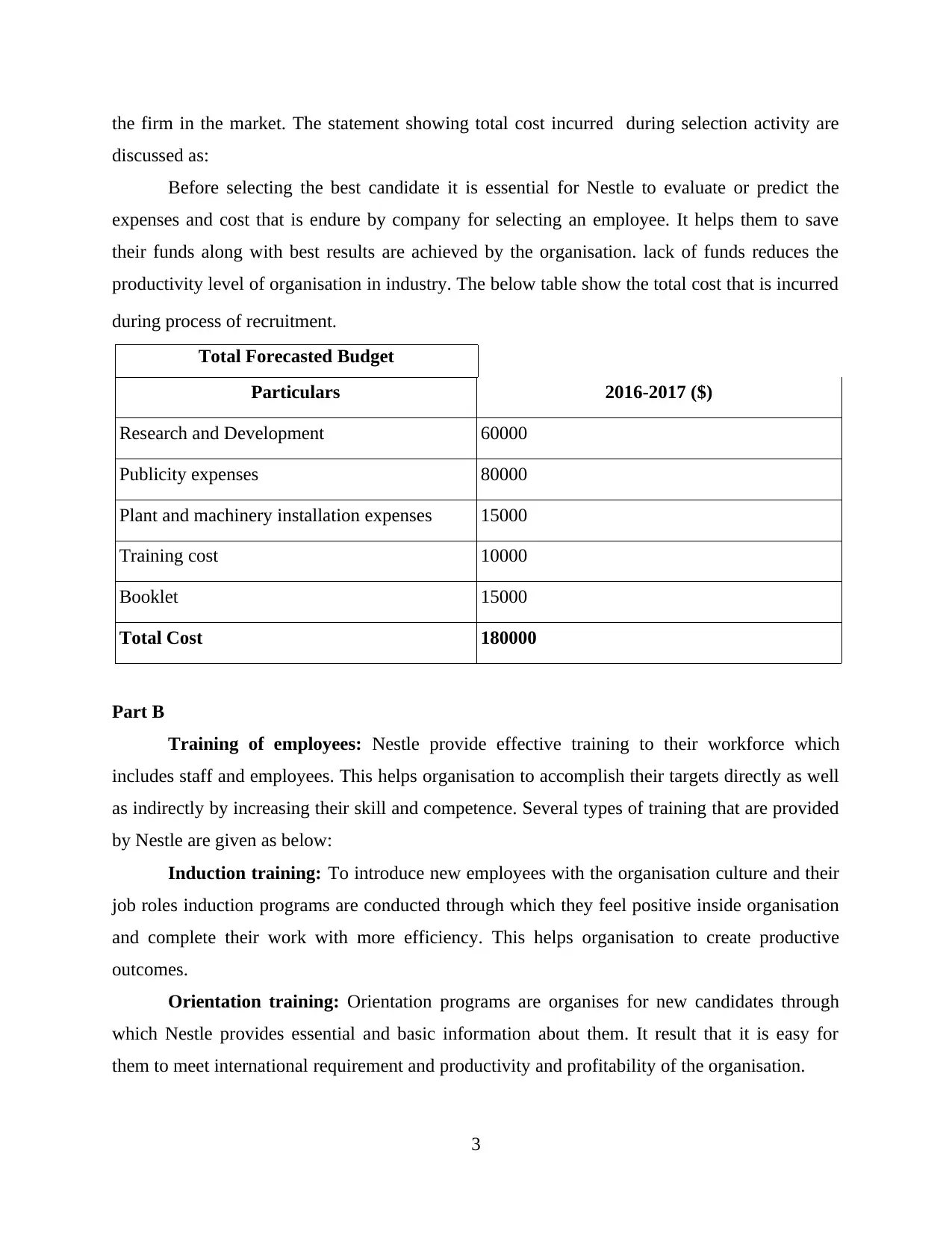
the firm in the market. The statement showing total cost incurred during selection activity are
discussed as:
Before selecting the best candidate it is essential for Nestle to evaluate or predict the
expenses and cost that is endure by company for selecting an employee. It helps them to save
their funds along with best results are achieved by the organisation. lack of funds reduces the
productivity level of organisation in industry. The below table show the total cost that is incurred
during process of recruitment.
Total Forecasted Budget
Particulars 2016-2017 ($)
Research and Development 60000
Publicity expenses 80000
Plant and machinery installation expenses 15000
Training cost 10000
Booklet 15000
Total Cost 180000
Part B
Training of employees: Nestle provide effective training to their workforce which
includes staff and employees. This helps organisation to accomplish their targets directly as well
as indirectly by increasing their skill and competence. Several types of training that are provided
by Nestle are given as below:
Induction training: To introduce new employees with the organisation culture and their
job roles induction programs are conducted through which they feel positive inside organisation
and complete their work with more efficiency. This helps organisation to create productive
outcomes.
Orientation training: Orientation programs are organises for new candidates through
which Nestle provides essential and basic information about them. It result that it is easy for
them to meet international requirement and productivity and profitability of the organisation.
3
discussed as:
Before selecting the best candidate it is essential for Nestle to evaluate or predict the
expenses and cost that is endure by company for selecting an employee. It helps them to save
their funds along with best results are achieved by the organisation. lack of funds reduces the
productivity level of organisation in industry. The below table show the total cost that is incurred
during process of recruitment.
Total Forecasted Budget
Particulars 2016-2017 ($)
Research and Development 60000
Publicity expenses 80000
Plant and machinery installation expenses 15000
Training cost 10000
Booklet 15000
Total Cost 180000
Part B
Training of employees: Nestle provide effective training to their workforce which
includes staff and employees. This helps organisation to accomplish their targets directly as well
as indirectly by increasing their skill and competence. Several types of training that are provided
by Nestle are given as below:
Induction training: To introduce new employees with the organisation culture and their
job roles induction programs are conducted through which they feel positive inside organisation
and complete their work with more efficiency. This helps organisation to create productive
outcomes.
Orientation training: Orientation programs are organises for new candidates through
which Nestle provides essential and basic information about them. It result that it is easy for
them to meet international requirement and productivity and profitability of the organisation.
3
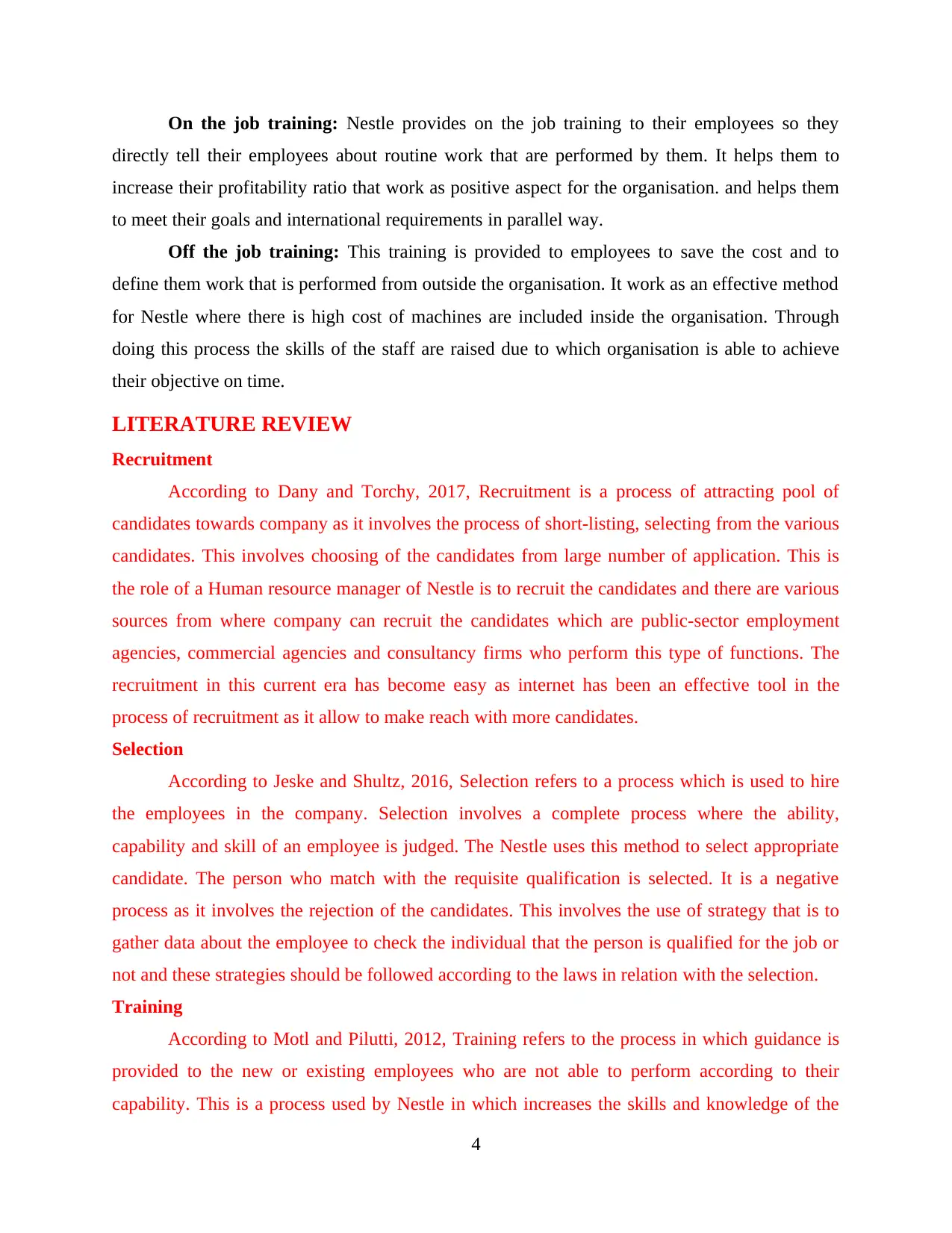
On the job training: Nestle provides on the job training to their employees so they
directly tell their employees about routine work that are performed by them. It helps them to
increase their profitability ratio that work as positive aspect for the organisation. and helps them
to meet their goals and international requirements in parallel way.
Off the job training: This training is provided to employees to save the cost and to
define them work that is performed from outside the organisation. It work as an effective method
for Nestle where there is high cost of machines are included inside the organisation. Through
doing this process the skills of the staff are raised due to which organisation is able to achieve
their objective on time.
LITERATURE REVIEW
Recruitment
According to Dany and Torchy, 2017, Recruitment is a process of attracting pool of
candidates towards company as it involves the process of short-listing, selecting from the various
candidates. This involves choosing of the candidates from large number of application. This is
the role of a Human resource manager of Nestle is to recruit the candidates and there are various
sources from where company can recruit the candidates which are public-sector employment
agencies, commercial agencies and consultancy firms who perform this type of functions. The
recruitment in this current era has become easy as internet has been an effective tool in the
process of recruitment as it allow to make reach with more candidates.
Selection
According to Jeske and Shultz, 2016, Selection refers to a process which is used to hire
the employees in the company. Selection involves a complete process where the ability,
capability and skill of an employee is judged. The Nestle uses this method to select appropriate
candidate. The person who match with the requisite qualification is selected. It is a negative
process as it involves the rejection of the candidates. This involves the use of strategy that is to
gather data about the employee to check the individual that the person is qualified for the job or
not and these strategies should be followed according to the laws in relation with the selection.
Training
According to Motl and Pilutti, 2012, Training refers to the process in which guidance is
provided to the new or existing employees who are not able to perform according to their
capability. This is a process used by Nestle in which increases the skills and knowledge of the
4
directly tell their employees about routine work that are performed by them. It helps them to
increase their profitability ratio that work as positive aspect for the organisation. and helps them
to meet their goals and international requirements in parallel way.
Off the job training: This training is provided to employees to save the cost and to
define them work that is performed from outside the organisation. It work as an effective method
for Nestle where there is high cost of machines are included inside the organisation. Through
doing this process the skills of the staff are raised due to which organisation is able to achieve
their objective on time.
LITERATURE REVIEW
Recruitment
According to Dany and Torchy, 2017, Recruitment is a process of attracting pool of
candidates towards company as it involves the process of short-listing, selecting from the various
candidates. This involves choosing of the candidates from large number of application. This is
the role of a Human resource manager of Nestle is to recruit the candidates and there are various
sources from where company can recruit the candidates which are public-sector employment
agencies, commercial agencies and consultancy firms who perform this type of functions. The
recruitment in this current era has become easy as internet has been an effective tool in the
process of recruitment as it allow to make reach with more candidates.
Selection
According to Jeske and Shultz, 2016, Selection refers to a process which is used to hire
the employees in the company. Selection involves a complete process where the ability,
capability and skill of an employee is judged. The Nestle uses this method to select appropriate
candidate. The person who match with the requisite qualification is selected. It is a negative
process as it involves the rejection of the candidates. This involves the use of strategy that is to
gather data about the employee to check the individual that the person is qualified for the job or
not and these strategies should be followed according to the laws in relation with the selection.
Training
According to Motl and Pilutti, 2012, Training refers to the process in which guidance is
provided to the new or existing employees who are not able to perform according to their
capability. This is a process used by Nestle in which increases the skills and knowledge of the
4
⊘ This is a preview!⊘
Do you want full access?
Subscribe today to unlock all pages.

Trusted by 1+ million students worldwide
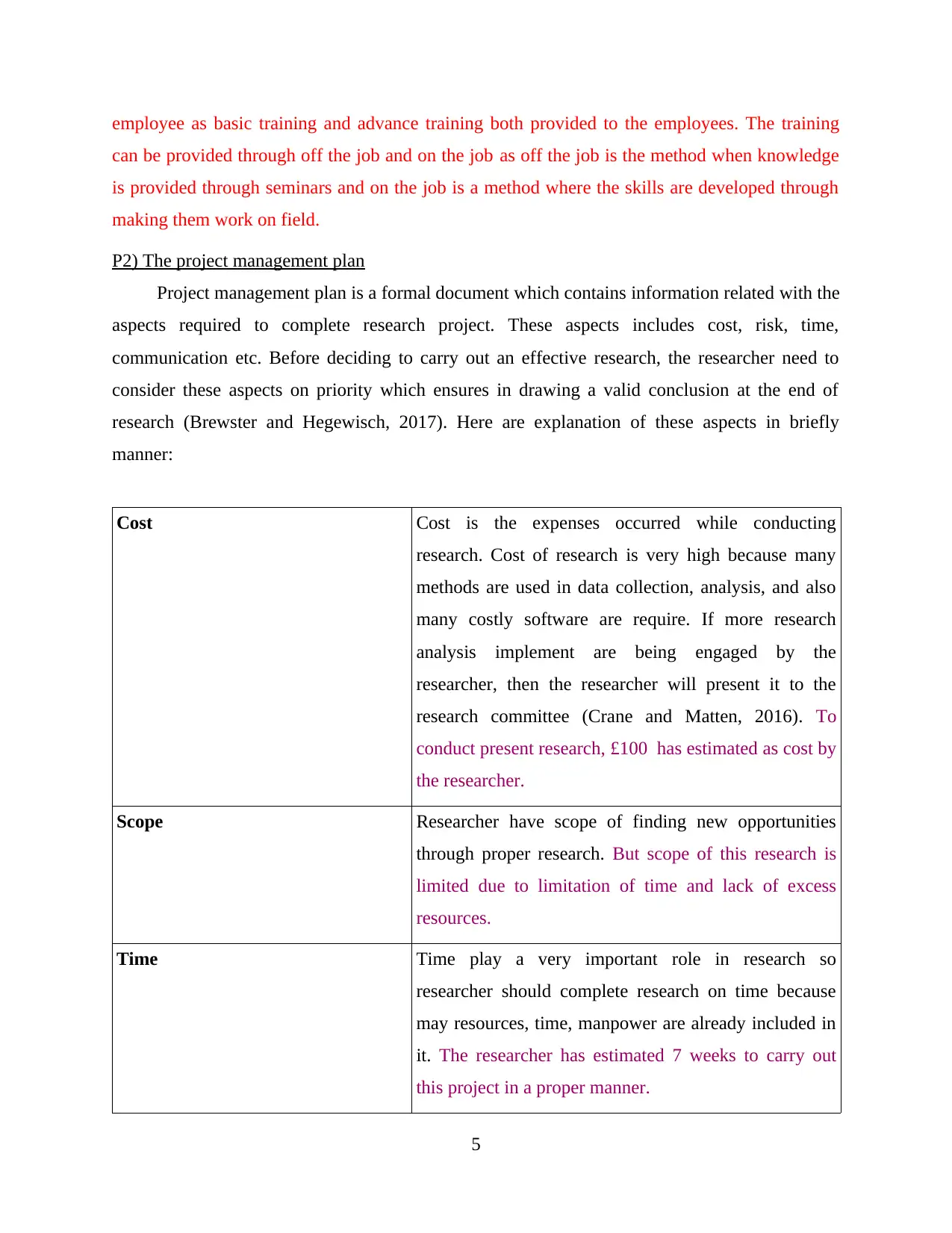
employee as basic training and advance training both provided to the employees. The training
can be provided through off the job and on the job as off the job is the method when knowledge
is provided through seminars and on the job is a method where the skills are developed through
making them work on field.
P2) The project management plan
Project management plan is a formal document which contains information related with the
aspects required to complete research project. These aspects includes cost, risk, time,
communication etc. Before deciding to carry out an effective research, the researcher need to
consider these aspects on priority which ensures in drawing a valid conclusion at the end of
research (Brewster and Hegewisch, 2017). Here are explanation of these aspects in briefly
manner:
Cost Cost is the expenses occurred while conducting
research. Cost of research is very high because many
methods are used in data collection, analysis, and also
many costly software are require. If more research
analysis implement are being engaged by the
researcher, then the researcher will present it to the
research committee (Crane and Matten, 2016). To
conduct present research, £100 has estimated as cost by
the researcher.
Scope Researcher have scope of finding new opportunities
through proper research. But scope of this research is
limited due to limitation of time and lack of excess
resources.
Time Time play a very important role in research so
researcher should complete research on time because
may resources, time, manpower are already included in
it. The researcher has estimated 7 weeks to carry out
this project in a proper manner.
5
can be provided through off the job and on the job as off the job is the method when knowledge
is provided through seminars and on the job is a method where the skills are developed through
making them work on field.
P2) The project management plan
Project management plan is a formal document which contains information related with the
aspects required to complete research project. These aspects includes cost, risk, time,
communication etc. Before deciding to carry out an effective research, the researcher need to
consider these aspects on priority which ensures in drawing a valid conclusion at the end of
research (Brewster and Hegewisch, 2017). Here are explanation of these aspects in briefly
manner:
Cost Cost is the expenses occurred while conducting
research. Cost of research is very high because many
methods are used in data collection, analysis, and also
many costly software are require. If more research
analysis implement are being engaged by the
researcher, then the researcher will present it to the
research committee (Crane and Matten, 2016). To
conduct present research, £100 has estimated as cost by
the researcher.
Scope Researcher have scope of finding new opportunities
through proper research. But scope of this research is
limited due to limitation of time and lack of excess
resources.
Time Time play a very important role in research so
researcher should complete research on time because
may resources, time, manpower are already included in
it. The researcher has estimated 7 weeks to carry out
this project in a proper manner.
5
Paraphrase This Document
Need a fresh take? Get an instant paraphrase of this document with our AI Paraphraser
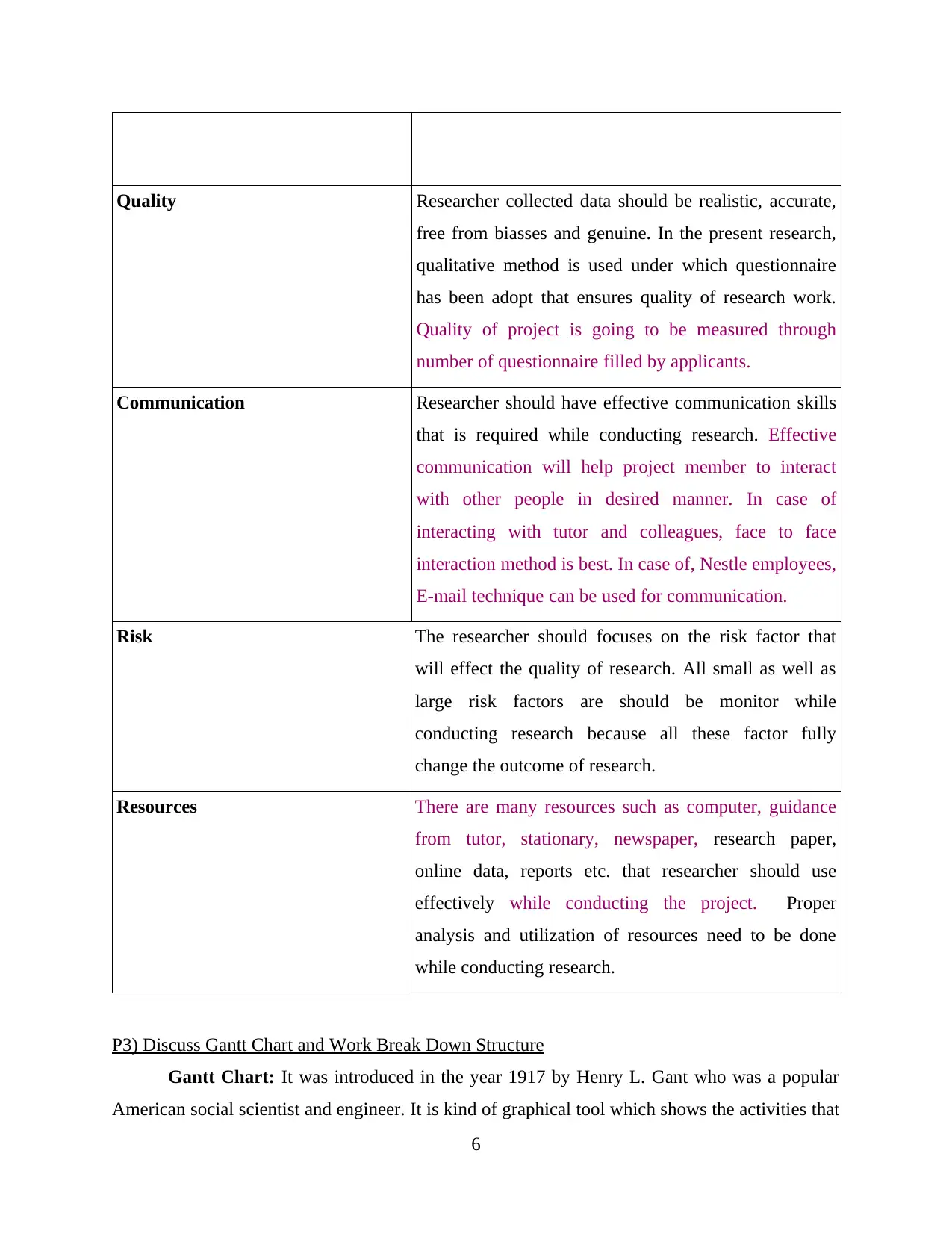
Quality Researcher collected data should be realistic, accurate,
free from biasses and genuine. In the present research,
qualitative method is used under which questionnaire
has been adopt that ensures quality of research work.
Quality of project is going to be measured through
number of questionnaire filled by applicants.
Communication Researcher should have effective communication skills
that is required while conducting research. Effective
communication will help project member to interact
with other people in desired manner. In case of
interacting with tutor and colleagues, face to face
interaction method is best. In case of, Nestle employees,
E-mail technique can be used for communication.
Risk The researcher should focuses on the risk factor that
will effect the quality of research. All small as well as
large risk factors are should be monitor while
conducting research because all these factor fully
change the outcome of research.
Resources There are many resources such as computer, guidance
from tutor, stationary, newspaper, research paper,
online data, reports etc. that researcher should use
effectively while conducting the project. Proper
analysis and utilization of resources need to be done
while conducting research.
P3) Discuss Gantt Chart and Work Break Down Structure
Gantt Chart: It was introduced in the year 1917 by Henry L. Gant who was a popular
American social scientist and engineer. It is kind of graphical tool which shows the activities that
6
free from biasses and genuine. In the present research,
qualitative method is used under which questionnaire
has been adopt that ensures quality of research work.
Quality of project is going to be measured through
number of questionnaire filled by applicants.
Communication Researcher should have effective communication skills
that is required while conducting research. Effective
communication will help project member to interact
with other people in desired manner. In case of
interacting with tutor and colleagues, face to face
interaction method is best. In case of, Nestle employees,
E-mail technique can be used for communication.
Risk The researcher should focuses on the risk factor that
will effect the quality of research. All small as well as
large risk factors are should be monitor while
conducting research because all these factor fully
change the outcome of research.
Resources There are many resources such as computer, guidance
from tutor, stationary, newspaper, research paper,
online data, reports etc. that researcher should use
effectively while conducting the project. Proper
analysis and utilization of resources need to be done
while conducting research.
P3) Discuss Gantt Chart and Work Break Down Structure
Gantt Chart: It was introduced in the year 1917 by Henry L. Gant who was a popular
American social scientist and engineer. It is kind of graphical tool which shows the activities that
6
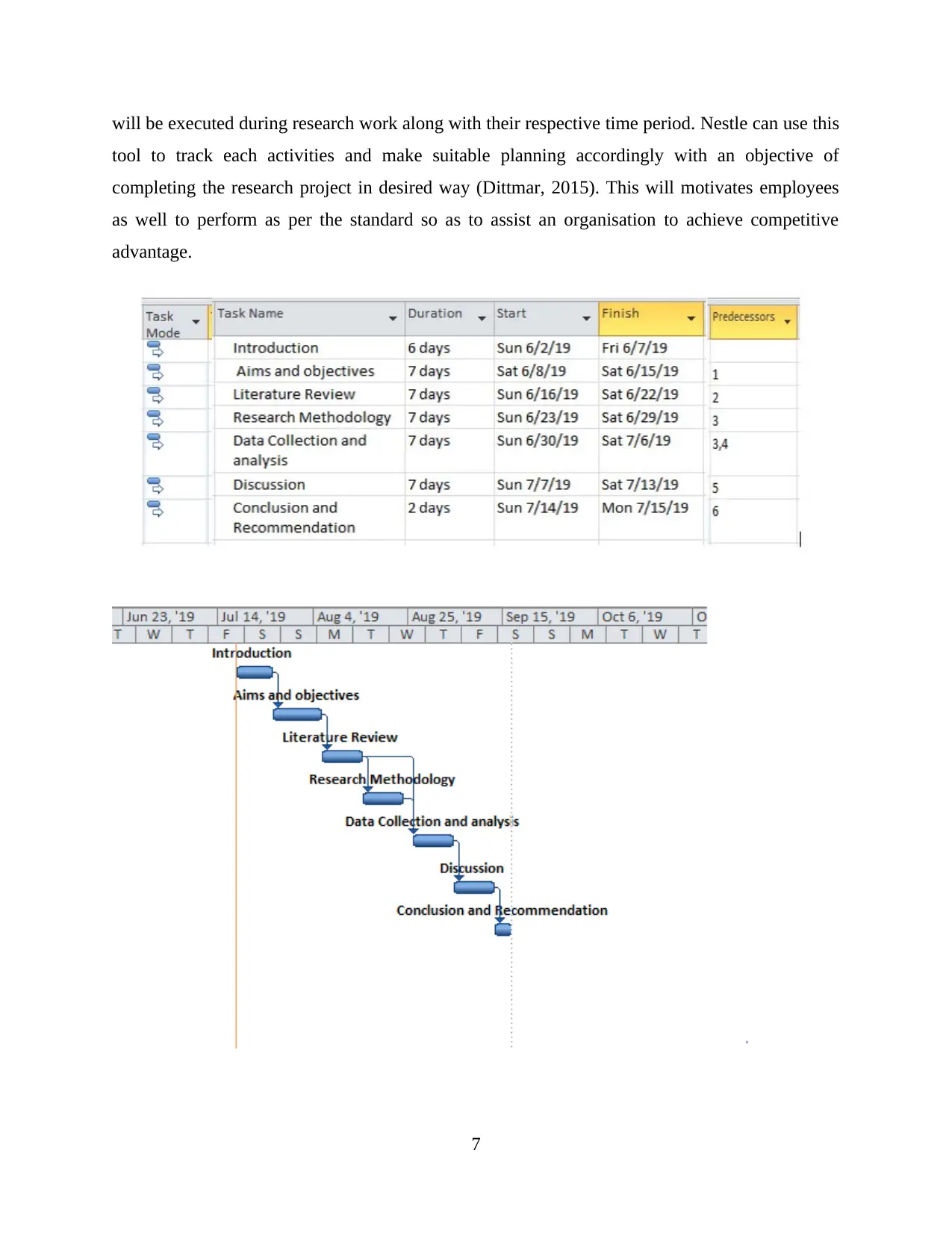
will be executed during research work along with their respective time period. Nestle can use this
tool to track each activities and make suitable planning accordingly with an objective of
completing the research project in desired way (Dittmar, 2015). This will motivates employees
as well to perform as per the standard so as to assist an organisation to achieve competitive
advantage.
7
tool to track each activities and make suitable planning accordingly with an objective of
completing the research project in desired way (Dittmar, 2015). This will motivates employees
as well to perform as per the standard so as to assist an organisation to achieve competitive
advantage.
7
⊘ This is a preview!⊘
Do you want full access?
Subscribe today to unlock all pages.

Trusted by 1+ million students worldwide
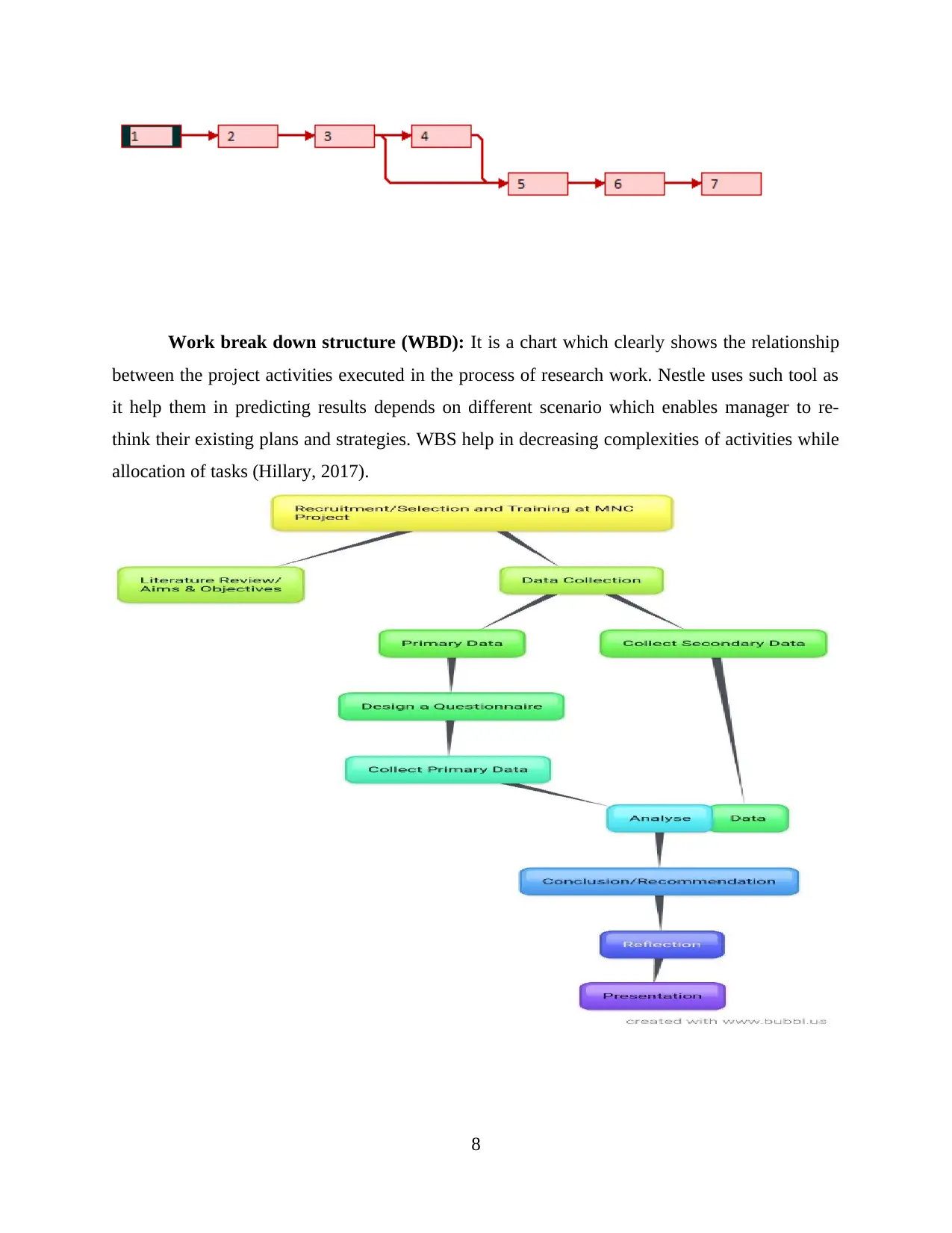
Work break down structure (WBD): It is a chart which clearly shows the relationship
between the project activities executed in the process of research work. Nestle uses such tool as
it help them in predicting results depends on different scenario which enables manager to re-
think their existing plans and strategies. WBS help in decreasing complexities of activities while
allocation of tasks (Hillary, 2017).
8
between the project activities executed in the process of research work. Nestle uses such tool as
it help them in predicting results depends on different scenario which enables manager to re-
think their existing plans and strategies. WBS help in decreasing complexities of activities while
allocation of tasks (Hillary, 2017).
8
Paraphrase This Document
Need a fresh take? Get an instant paraphrase of this document with our AI Paraphraser
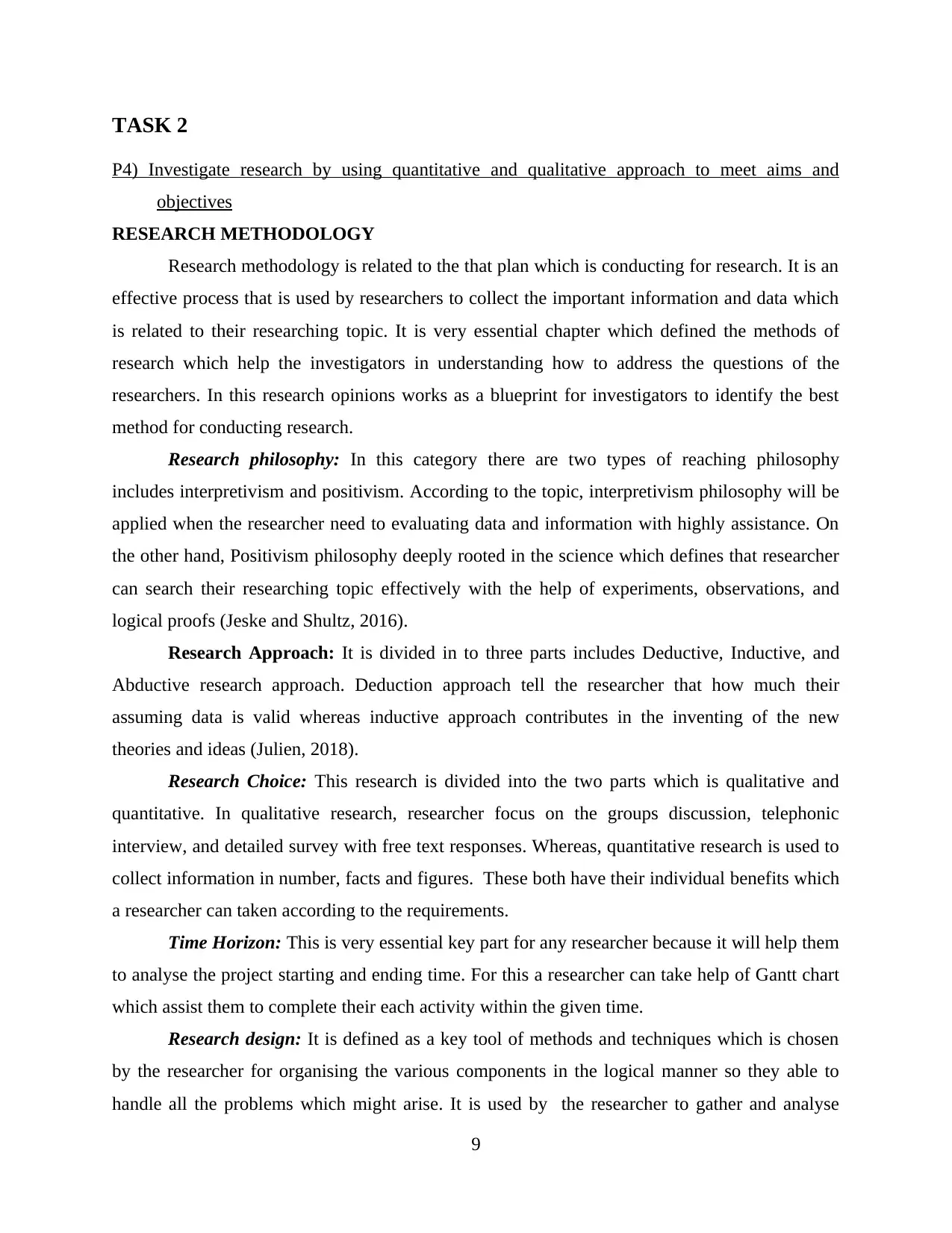
TASK 2
P4) Investigate research by using quantitative and qualitative approach to meet aims and
objectives
RESEARCH METHODOLOGY
Research methodology is related to the that plan which is conducting for research. It is an
effective process that is used by researchers to collect the important information and data which
is related to their researching topic. It is very essential chapter which defined the methods of
research which help the investigators in understanding how to address the questions of the
researchers. In this research opinions works as a blueprint for investigators to identify the best
method for conducting research.
Research philosophy: In this category there are two types of reaching philosophy
includes interpretivism and positivism. According to the topic, interpretivism philosophy will be
applied when the researcher need to evaluating data and information with highly assistance. On
the other hand, Positivism philosophy deeply rooted in the science which defines that researcher
can search their researching topic effectively with the help of experiments, observations, and
logical proofs (Jeske and Shultz, 2016).
Research Approach: It is divided in to three parts includes Deductive, Inductive, and
Abductive research approach. Deduction approach tell the researcher that how much their
assuming data is valid whereas inductive approach contributes in the inventing of the new
theories and ideas (Julien, 2018).
Research Choice: This research is divided into the two parts which is qualitative and
quantitative. In qualitative research, researcher focus on the groups discussion, telephonic
interview, and detailed survey with free text responses. Whereas, quantitative research is used to
collect information in number, facts and figures. These both have their individual benefits which
a researcher can taken according to the requirements.
Time Horizon: This is very essential key part for any researcher because it will help them
to analyse the project starting and ending time. For this a researcher can take help of Gantt chart
which assist them to complete their each activity within the given time.
Research design: It is defined as a key tool of methods and techniques which is chosen
by the researcher for organising the various components in the logical manner so they able to
handle all the problems which might arise. It is used by the researcher to gather and analyse
9
P4) Investigate research by using quantitative and qualitative approach to meet aims and
objectives
RESEARCH METHODOLOGY
Research methodology is related to the that plan which is conducting for research. It is an
effective process that is used by researchers to collect the important information and data which
is related to their researching topic. It is very essential chapter which defined the methods of
research which help the investigators in understanding how to address the questions of the
researchers. In this research opinions works as a blueprint for investigators to identify the best
method for conducting research.
Research philosophy: In this category there are two types of reaching philosophy
includes interpretivism and positivism. According to the topic, interpretivism philosophy will be
applied when the researcher need to evaluating data and information with highly assistance. On
the other hand, Positivism philosophy deeply rooted in the science which defines that researcher
can search their researching topic effectively with the help of experiments, observations, and
logical proofs (Jeske and Shultz, 2016).
Research Approach: It is divided in to three parts includes Deductive, Inductive, and
Abductive research approach. Deduction approach tell the researcher that how much their
assuming data is valid whereas inductive approach contributes in the inventing of the new
theories and ideas (Julien, 2018).
Research Choice: This research is divided into the two parts which is qualitative and
quantitative. In qualitative research, researcher focus on the groups discussion, telephonic
interview, and detailed survey with free text responses. Whereas, quantitative research is used to
collect information in number, facts and figures. These both have their individual benefits which
a researcher can taken according to the requirements.
Time Horizon: This is very essential key part for any researcher because it will help them
to analyse the project starting and ending time. For this a researcher can take help of Gantt chart
which assist them to complete their each activity within the given time.
Research design: It is defined as a key tool of methods and techniques which is chosen
by the researcher for organising the various components in the logical manner so they able to
handle all the problems which might arise. It is used by the researcher to gather and analyse
9
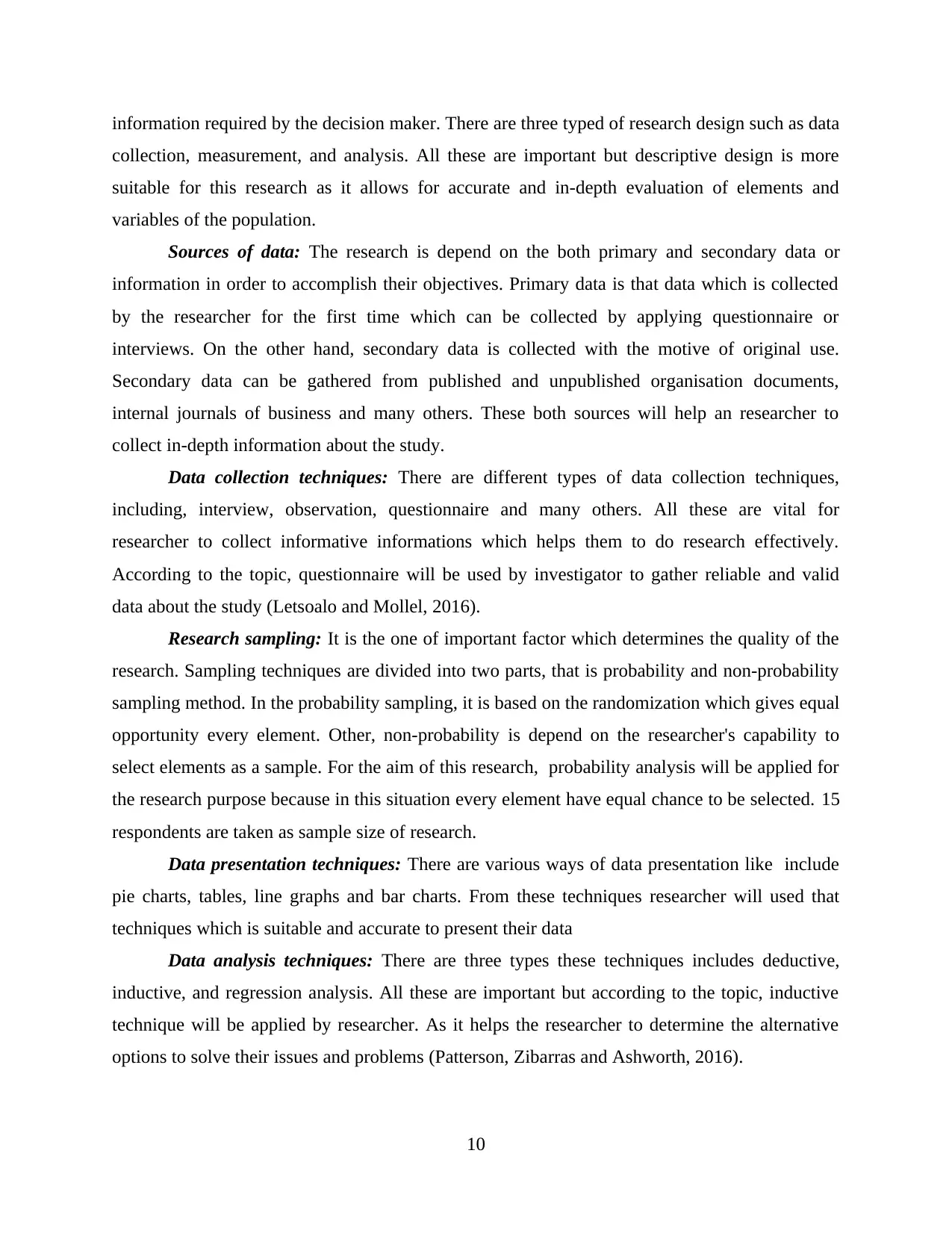
information required by the decision maker. There are three typed of research design such as data
collection, measurement, and analysis. All these are important but descriptive design is more
suitable for this research as it allows for accurate and in-depth evaluation of elements and
variables of the population.
Sources of data: The research is depend on the both primary and secondary data or
information in order to accomplish their objectives. Primary data is that data which is collected
by the researcher for the first time which can be collected by applying questionnaire or
interviews. On the other hand, secondary data is collected with the motive of original use.
Secondary data can be gathered from published and unpublished organisation documents,
internal journals of business and many others. These both sources will help an researcher to
collect in-depth information about the study.
Data collection techniques: There are different types of data collection techniques,
including, interview, observation, questionnaire and many others. All these are vital for
researcher to collect informative informations which helps them to do research effectively.
According to the topic, questionnaire will be used by investigator to gather reliable and valid
data about the study (Letsoalo and Mollel, 2016).
Research sampling: It is the one of important factor which determines the quality of the
research. Sampling techniques are divided into two parts, that is probability and non-probability
sampling method. In the probability sampling, it is based on the randomization which gives equal
opportunity every element. Other, non-probability is depend on the researcher's capability to
select elements as a sample. For the aim of this research, probability analysis will be applied for
the research purpose because in this situation every element have equal chance to be selected. 15
respondents are taken as sample size of research.
Data presentation techniques: There are various ways of data presentation like include
pie charts, tables, line graphs and bar charts. From these techniques researcher will used that
techniques which is suitable and accurate to present their data
Data analysis techniques: There are three types these techniques includes deductive,
inductive, and regression analysis. All these are important but according to the topic, inductive
technique will be applied by researcher. As it helps the researcher to determine the alternative
options to solve their issues and problems (Patterson, Zibarras and Ashworth, 2016).
10
collection, measurement, and analysis. All these are important but descriptive design is more
suitable for this research as it allows for accurate and in-depth evaluation of elements and
variables of the population.
Sources of data: The research is depend on the both primary and secondary data or
information in order to accomplish their objectives. Primary data is that data which is collected
by the researcher for the first time which can be collected by applying questionnaire or
interviews. On the other hand, secondary data is collected with the motive of original use.
Secondary data can be gathered from published and unpublished organisation documents,
internal journals of business and many others. These both sources will help an researcher to
collect in-depth information about the study.
Data collection techniques: There are different types of data collection techniques,
including, interview, observation, questionnaire and many others. All these are vital for
researcher to collect informative informations which helps them to do research effectively.
According to the topic, questionnaire will be used by investigator to gather reliable and valid
data about the study (Letsoalo and Mollel, 2016).
Research sampling: It is the one of important factor which determines the quality of the
research. Sampling techniques are divided into two parts, that is probability and non-probability
sampling method. In the probability sampling, it is based on the randomization which gives equal
opportunity every element. Other, non-probability is depend on the researcher's capability to
select elements as a sample. For the aim of this research, probability analysis will be applied for
the research purpose because in this situation every element have equal chance to be selected. 15
respondents are taken as sample size of research.
Data presentation techniques: There are various ways of data presentation like include
pie charts, tables, line graphs and bar charts. From these techniques researcher will used that
techniques which is suitable and accurate to present their data
Data analysis techniques: There are three types these techniques includes deductive,
inductive, and regression analysis. All these are important but according to the topic, inductive
technique will be applied by researcher. As it helps the researcher to determine the alternative
options to solve their issues and problems (Patterson, Zibarras and Ashworth, 2016).
10
⊘ This is a preview!⊘
Do you want full access?
Subscribe today to unlock all pages.

Trusted by 1+ million students worldwide
1 out of 32
Related Documents
Your All-in-One AI-Powered Toolkit for Academic Success.
+13062052269
info@desklib.com
Available 24*7 on WhatsApp / Email
![[object Object]](/_next/static/media/star-bottom.7253800d.svg)
Unlock your academic potential
Copyright © 2020–2025 A2Z Services. All Rights Reserved. Developed and managed by ZUCOL.





